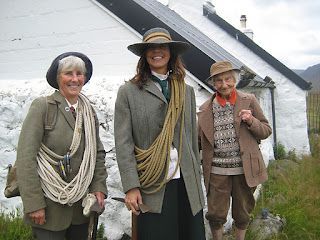Historical climbing re-enactment on Countryfile
 |
| Image from the BBC: http://goo.gl/SfQPe |
BBC1’s Countryfile is a programme that often covers topics related to mountaineering and the outdoors, but last night’s episode was particularly good and featured many locations and themes relevant to my novels. The episode focused on the Lochaber region of Scotland, and there were many shots of the Glencoe mountains (notably Buachaille Etive Mor and the ridges of Bidean nam Bian).
In addition to the stunning scenery, the episode covered an important event in the history of mountaineering: the formation of the Scottish Ladies Climbing Club. In 1908, this society was formed as a counterpart to the Scottish Mountaineering Club, but for women. Climbing was a different game in 1908 and in the episode Julia Bradbury (to whom I once served a sandwich, at the Clachaig!) dons the tweed and discovers what it was like for ladies climbing in the early 20th century.
Much of the equipment used in the re-enactment was perfectly accurate: tweed jackets and skirts, nailed boots, and long ice axes. Climbers tied in round the waist without any harness, and no runners were placed on the climb (which, if I recognised it correctly, was a Grade 3 scramble / Moderate rock climb called the North East Ridge of Creag Coire na Tulaich).
Historical climbing re-enactment has been in the news a fair bit over the last couple of years, notably in the 2009/2010 season when Dave MacLeod and Andy Turner conducted the Jimmy Marshall Project. It’s great to see some recognition for the illustrious history of mountaineering in a high profile BBC programme.
Readers might be interested to know that, in the name of research for my novels, I conducted a campaign into the use of late Victorian mountaineering equipment between 2009 and 2011. I named it the Raeburn Project after the Scottish climber Harold Raeburn, who made the first winter ascent of Green Gully in 1906 using relatively primitive equipment. The results of my experiment were startling: tweed clothing is astoundingly effective for winter climbing in Scotland, nailed boots are excellent on hard snow, and a weighty Victorian ice axe is a powerful tool for step-cutting. Compared to modern attitudes, I learned how to place less reliance on technology and gear, and more reliance on my own skills and observations. It was an eye-opening experience–one that really enabled me to get into the minds of my characters who would have used this equipment in the late 19th century.
Alex Roddie Newsletter
Join the newsletter to receive the latest updates in your inbox.



